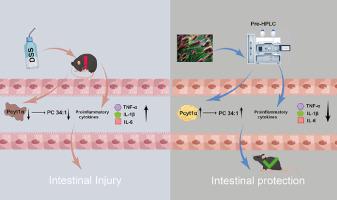Phytomedicine ( IF 7.9 ) Pub Date : 2023-05-09 , DOI: 10.1016/j.phymed.2023.154870 Tengjie Yu 1 , Linlin Wu 1 , Tingting Zhang 1 , Hongyuan Hao 2 , Jing Dong 2 , Yexin Xu 1 , Huizhu Yang 1 , Huafang Liu 1 , Lin Xie 1 , Guangji Wang 1 , Yan Liang 1

|
Background
Sanguisorba saponin extract (SSE) is the main active part of Sanguisorba officinalis with various pharmacological activities such as anti-inflammatory, anti-bacterial and anti-oxidant. However, its therapeutic role and underlying mechanisms for ulcerative colitis (UC) still need to be elucidated.
Purpose
This study aims to explore the therapeutic effect, effectiveness-material basis-quality markers (Q-markers) and prospective mechanism of function of SSE on UC.
Methods
Fresh 2.5% dextran sulfate sodium salt (DSS) solution was placed in drinking bottles for 7 days to induce a mouse model of UC. SSE and sulfasalazine (SASP) were supplemented to mice by gavage for consecutive 7 days to investigate the therapeutic role of SSE on UC. Mouse monocyte macrophages (RAW264.7) and human normal colonic epithelial (NCM460) cells were treated with LPS to induce inflammatory responses, followed by pharmacodynamic examination with different concentrations of SSE. Hematoxylin-eosin (HE) and Alcian blue staining were conducted to evaluate the pathological damage of mice colon. Lipidomic technology was conducted to explore the differential lipids closely related to the disease process of UC. Quantitative PCR analysis, immunohistochemistry and ELISA kit were used to measure the expression levels of the corresponding proteins and pro-inflammatory factors.
Results
SSE treatment could effectively reduce the elevated expressions of pro-inflammatory factors in RAW264.7 and NCM460 cells due to LPS stimulation. Intragastric administration of SSE was found to significantly alleviate the symptoms of DSS-induced colon injury and low-polar saponins in SSE. Low polarity saponins, especially ZYS-II, were proved to be the main active substances of SSE in treating UC. In addition, SSE could significantly ameliorate the aberrant lipid metabolism in UC mice. The role of phosphatidylcholine (PC)34:1 in the UC pathogenesis has been fully verified in our previous studies. Herein, SSE-dosing effectively reversed the metabolic disorder of PCs in UC mice, and increased the PC34:1 level to normal via up-regulating the expression of phosphocholine cytidylyltransferase (PCYT1α).
Conclusion
Our data innovatively revealed that SSE could significantly alleviate the symptoms of UC by reversing the disorder of PC metabolism induced by DSS modeling. SSE was proved for the first time to be a promising and effective candidate for UC treatment.
中文翻译:

基于脂质代谢调控的地榆皂苷治疗溃疡性结肠炎Q标志物及分子机制研究
背景
地榆皂甙提取物(SSE)是地榆的主要活性成分,具有抗炎、抗菌、抗氧化等多种药理活性。然而,其对溃疡性结肠炎 (UC) 的治疗作用和潜在机制仍有待阐明。
目的
本研究旨在探讨SSE对UC的治疗作用、有效性-物质基础-质量标志物(Q-markers)及前瞻性作用机制。
方法
将新鲜的 2.5% 葡聚糖硫酸钠盐 (DSS) 溶液置于饮用瓶中 7 天,以诱导 UC 小鼠模型。通过连续 7 天给小鼠灌胃补充 SSE 和柳氮磺胺吡啶 (SASP),以研究 SSE 对 UC 的治疗作用。小鼠单核巨噬细胞 (RAW264.7) 和人正常结肠上皮细胞 (NCM460) 用 LPS 处理以诱导炎症反应,然后用不同浓度的 SSE 进行药效学检查。进行苏木精-伊红(HE)和阿尔新蓝染色以评估小鼠结肠的病理损伤。采用脂质组学技术探索与UC发病过程密切相关的差异脂质。定量PCR分析,
结果
SSE处理可有效降低LPS刺激导致的RAW264.7和NCM460细胞促炎因子表达升高。发现 SSE 的灌胃可显着减轻 DSS 诱导的结肠损伤和 SSE 中的低极性皂苷的症状。低极性皂苷,尤其是ZYS-II,被证明是SSE治疗UC的主要活性物质。此外,SSE 可以显着改善 UC 小鼠的异常脂质代谢。磷脂酰胆碱 (PC)34:1 在 UC 发病机制中的作用已在我们之前的研究中得到充分验证。在此,SSE 给药有效逆转了 UC 小鼠 PC 的代谢紊乱,并通过上调磷酸胆碱胞苷酰转移酶 (PCYT1α) 的表达将 PC34:1 水平提高至正常水平。
结论
我们的数据创新地揭示了 SSE 可以通过逆转 DSS 建模诱导的 PC 代谢紊乱来显着减轻 UC 的症状。SSE 首次被证明是 UC 治疗的有前途和有效的候选者。



























 京公网安备 11010802027423号
京公网安备 11010802027423号